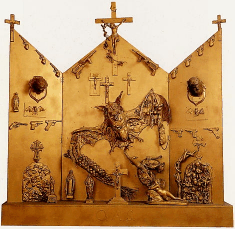
John Ashbery
Niki de Saint-Phalle (1962)
Niki turns the vulnerability of art to her account by a simple process of extermination. A work of art, like an animal, must be harmed before It can harm. So each new painting takes on the solemnity of a martyrdom. The novelty of her using a gun has somewhat obscured the fact that a ritual is involved. The important thing to remember about a martyrdom is not the cruelty and suffering, but that a transformation is taking place. By pumping the painting full of lead Niki is in fact enabling it to become more like itself, to satisfy its potentialities and desires.
Her talent for deification is more than ever evident in her cathedrals, which seem to be the product of a collaboration by Lautréamont, Huysmans, Cellini, Sade, Giotto, Jarry and César Frank, and in which the white mass and the black mass are transformed into the gold mass. All material is redeemed — a religious statuette and a stuffed rat are coated with the same gold, made to exist side by side in the same firmament.

A gothic austerity is reconciled with the golden calf. And just as his conflicting tastes are resolved by the individual, hell and heaven exist in an intimate union in these scandalous cathedrals through which float the wings of vampires, symbols both of love and death. Everythlng becomes holy when she looks at it, and everything turns to gold when she touches it, gold being an excellent material for the king of holiness she has in mind.
These new works are, then, religious, and this fact perhaps explains the new freedom of composition and improvisation which she brings to them. For her space is the kind we find only in religious art — the cathedrals, Mantegna, Caravaggio’s Martyrdom of St. Matthew, Delacroix’s Heliodorus Cast from the Temple.
This is because theology develops the painter’s ideas of space: the meaningfulness of up and down, the value of lost moments, how many angels can stend on the head of a pin, how to reclaim a few more inches from darkness. Niki’s cathedrals are swarming with the great possibilities of space: she makes us feel the importance of distances and heights, motion and stillness, light and dark, how all these things exist together for our pleasure and instruction and how these last two are also one and the same.
Published in NIKI SAINT-PHALLE catalog of the showing of the Centre G. Pompidou M.N.A.M. of Paris, july 1980.
John Ashbery: Niki de Saint-Phalle (1962) (français)